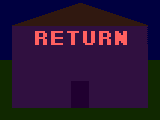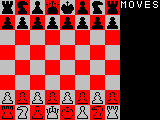
How do you play Marble Pool-ball?
1. Introduction and needed items
Marble Pool-ball is a cross between pool and pinball. It's setup and playing rules are of the simplest of any game I have as of Dec 7, 2003. To read about it's history of development, click here
This game requires few things:
26-51 marbles [must have 25 [easy], 35 [medium] or 50 [hard] small marbles and one large marble]
1 flat surface that is thin and doesn't bend such as a CD case and must be greater than 4 inches, but less than 6 inches wide [10-15 cm] and from 4 to 6 inches high [10-15 cm]
1 surface that is hard, heavy, and greater than half the width of your ramp and from 1 1/4 to 1 3/4 inches high [3.1 to 4.4 cm]. The closer to 1 1/2 inch the better. You can use books, stack them, whatever neccessary.
1 carpeted area at least 1 foot of which is clear of junk [no hard areas allowed!].
There are three difficulty levels: Easy, medium, and hard.
2. Game setup
First, you need an area that is 1 foot by 1 foot [30.5 by 30.5 cm]. Draw a square that is 1 foot by 1 foot. The square doesn't need to be perfect, but the closer, the better. Then, draw a line from the center of where you're going to be toward the the upper left and right corners like so:

This area is the boundaries in which the marbles are started from. The marbles are most accessible from there. You can group them however you wish, but they *MUST* be within four inches [ten centimeters] from the upper edge. The point in which the two lines connecting the center and corners meet is where you would place your ramp. To construct the ramp, simply take your surface that is hard [like books or a large, very flat and smooth rock] and lay them distant from the center point away from the square. Then, take your ramp and lean it against the rock or books so that the edge touches the edge of the square. The optimal distance is about three to six inches away. The further, the easier and further your marbles will go [and faster they'll go, too]. This is all setup really requires.
3. How to play (all difficulties)
First, after set up, get the required number of balls for your chosen difficulty [5, 4, 3 for easy, medium, and hard respectively]. Then, put 25, 35 or 50 marbles into the pool within setup border lines as described in the diagram above. To make a play, aim for the marbles in the pool and roll your large marble into the pool. If you miss, you lose a ball, if you touch or hit them [a minor touch is considered a hit, unless it's too minor to tell [if that is the case, flip a coin or roll a dice to let probability decide [this is what I do if I definitely can't tell on anything]. Heads will be that you keep the ball and considered a hit and tails means you lose a ball.].]. In any case, whether hit or not, you should always carefully remove your ball so that it doesn't bump the other marbles. If any of the marbles go outside the square to the left or right, they'll have to be moved back in at the same height level. For example, the blue marble would be moved to the red location. This assumes the medium difficulty for the image:

- Dark green marbles are good as they are.
- Magenta marbles are hard to get to but still allowed unless they were placed there. You may move these marbles inbounds more, but this is not allowed in hard mode.
- Gray marbles are places that are allowed for placement if under the line but are still okay, but hard to get to.
- The blue marble is out of bounds and must be replaced regardless of difficulty.
- The red marble is where the blue marble should be placed [or along the line].
- The cyan marble is a questionable as it's on the boundary.
- The dark yellow marble is beyond the edge and is removed.
- The dark cyan line is all the possibilities in which the blue marble can be placed. Also, it is as far as marbles can be placed at start.
- The black lines are pool borders.
This board image explains a lot. Questionables are marbles on the top border or touching it, but not past the halfway point. If, for some reason, you cannot place the blue marble anywhere along the line, you must move it to the next row down and it's most available spot. When marbles are knocked past the half-way point on the pool, you need to remove them and set them to the side. Do not put these back into the pool, otherwise, you're giving yourself a big disadvantage. The object is to successfully clear all of the marbles without losing all your balls [like that of pinball]. You can earn extra balls, especially at the beginning of the game. This game tests your targeting with even better precision than Hit-a-bump*. Your goal is to endure as many rounds as possible before running out of marbles. The hard level is a real challenge for this, but it is still possible to reach round 5. If all the marbles have been removed, it is considered cleared and you can put all the marbles back in as you did in set up and continue. Each time you clear the pool, you finish a round and you gain a special number of extra balls for doing so, depending on your difficulty setting. The player with the most successful rounds wins. Or, for solo play, you need to complete 2 full rounds and half of the third to win. You can continue playing from there if you want. The highest I've had so far was 2.6 on the medium.
4. Rules at each difficulty setting
- You get five balls for easy, four for medium and three for hard.
- You get an extra ball if you knock three marbles out of the grid on the top in one roll and questionables are allowed, but count as 2 for 1 when playing in easy mode [i.e. 6 questionables is counted as 3 past the border]. You get an extra ball if you knock three marbles out of the grid on the top in one roll where questionables are not allowed [medium level rule]. You get an extra ball if you knock four marbles out of the grid on the top at the same time and questionables are not allowed, [hard level rule]. Any extras for easy and medium difficulties past 3 are yet one more extra ball, but it takes 2 extras past 4 for hard to gain an extra ball on top of the one you'd normally get.
- You put 25 marbles into the pool [The pool is described as the marbles scattered throughout the square.] for the easy level, 35 for medium, and 50 for hard.
- If the pool has been cleared in easy mode, you get 2 extra balls automatically to assist you on the next round. If playing in medium mode, you get only one extra ball. In hard mode, clearing the pool gives no bonuses.
Now that you have the rules, you can host big competitions with this game. The winner is the one with the most rounds cleared at the same difficulty. If, for some reason, there is a tie between the number of rounds cleared without losing all balls, refer to the number of marbles left in the pool by game's end. The one with the fewest wins. If a tie is still present, remove all but two marbles and place each marble quite distant from each other and each player who's tied rolls the big marble into the small one. Next, the second player does the same only with their marble. The one who rolled the furthest wins. If there is a miss, that is considered a distance of 0, a definite loss unless the other player got the same. If both miss, keep repeating the distance determination method until one gets their marble the furthest.
Footnotes:
* Hit-a-bump is a targetting game with six versions of play. You can learn 5 versions here.








